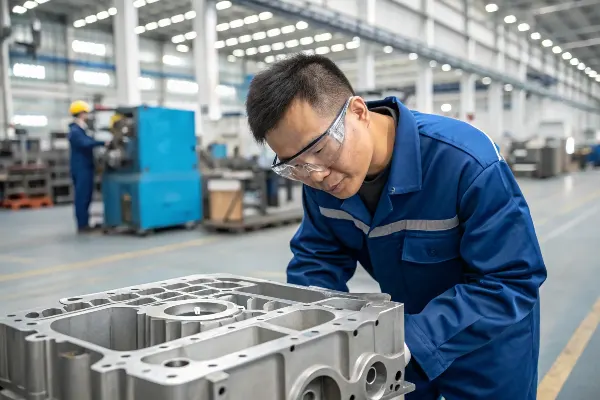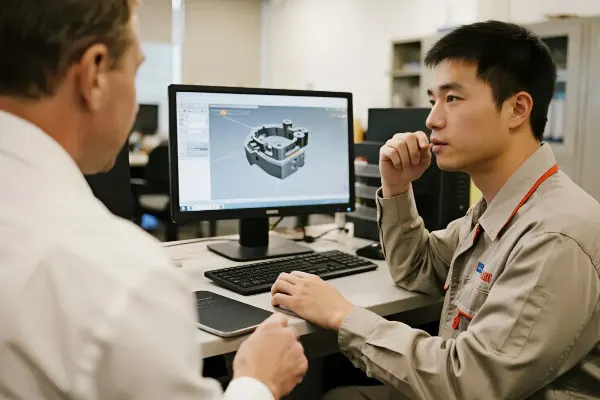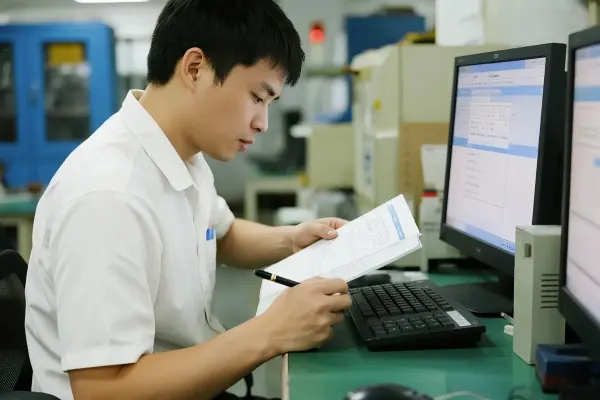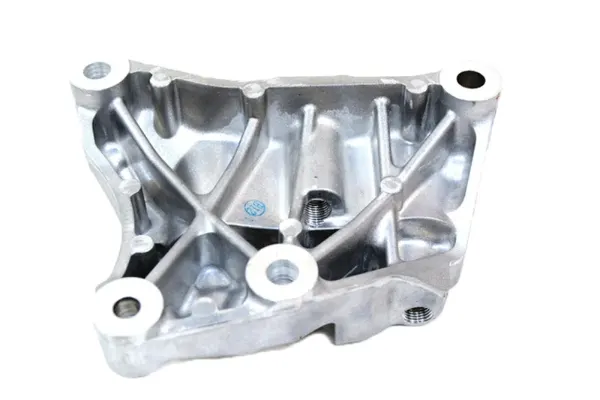Finding a reliable die casting partner feels difficult. A poor choice can lead to project delays, quality failures, and budget overruns. But knowing the right questions to ask simplifies everything.
The best way to find reliable die casting manufacturers1 is by thoroughly evaluating their technical capabilities2, documented quality systems like IATF 169493, and project management track record4. Look for transparent partners with proven experience in producing parts similar to yours, especially for demanding industries like automotive.

Finding the right supplier is more than just a search; it’s a vetting process. You need a partner who can handle the technical challenges and integrate smoothly into your supply chain. In my 20-plus years in this industry, I’ve seen firsthand what separates the average suppliers from the truly reliable partners who contribute to a project’s success. It boils down to a few key areas that you can investigate to make a confident decision. Let’s break down what you should be looking for.
What makes a die casting supplier truly reliable for critical automotive components?
Struggling with suppliers who over-promise and under-deliver? Inconsistent quality and missed deadlines can derail a critical automotive project. A reliable partner delivers more than just parts; they deliver predictable excellence.
A truly reliable supplier combines deep technical expertise in complex die casting with robust quality systems like IATF 169493. They offer transparent communication, proactive problem-solving, and act as a true partner by providing DFM5 and collaborative development support6 from the very beginning.

In my experience working with Tier 1s from Germany, the US, and Canada, reliability isn’t just a buzzword; it’s a set of tangible attributes we can measure. I’ve learned to break it down into three core pillars.
Technical Capability
A reliable supplier must have the right equipment, but more importantly, the right knowledge. For complex parts like motor controller housings for new energy vehicles, standard casting isn’t enough. I always check if they have mastered advanced processes. For example, do they use vacuum casting7 to minimize porosity for parts with high airtightness requirements? Or do they apply squeeze casting8 for structural parts that need superior mechanical properties? A partner who invests in and understands these technologies is prepared for modern automotive challenges.
Process Control
Consistency is everything in mass production. I look for suppliers who don’t just inspect quality at the end; they build it into the process. This means real-time monitoring9 of every shot on the die casting machine. The pressure, temperature, and velocity data should be tracked and controlled. A reliable factory can show you their SPC charts10 and explain how they use that data to prevent deviations before they happen. This is a non-negotiable for any serious automotive project.
Project Management
A great technical partner can still fail if their project management is weak. Reliability means clear communication, sticking to timelines, and proactive updates. When we work on a new project, we provide our partners with a detailed project plan from DFM5 analysis to delivery. A reliable supplier does the same. They should have a dedicated engineer who becomes your single point of contact, ensuring nothing gets lost in translation.
How can SQEs quickly assess whether a supplier can meet IATF 16949 and PPAP requirements?
Are you, as a Supplier Quality Engineer, buried in supplier documentation? It’s a huge challenge to quickly tell which suppliers truly live by quality standards and which ones just have a certificate.
To quickly assess a supplier, ask for their IATF 169493 certificate and review their PPAP submission history11 for similar parts. During your first technical call, ask specific questions about their APQP process12, control plan methods, and how they use SPC data for critical-to-quality features.

As an engineer who has helped many SQEs, I tell them to dig deeper than the paperwork. A certificate proves they passed an audit once, but you need to know how they operate every day. The right questions can reveal their true process maturity very quickly. I recommend focusing on practical evidence that shows their quality system is a living, breathing part of their operation, not just a binder on a shelf.
Here are a few things I advise SQEs to check:
| Assessment Area | What to Ask for or Look For | What it Tells You |
|---|---|---|
| Living Documents | "Can you show me the FMEA13 and Control Plan for a recent, complex project?" | If the documents are detailed and updated, it shows they actively manage risk. If they are generic, it’s a red flag. |
| Traceability | "If I give you a serial number from a finished part, can you trace it back to the aluminum batch, die cast machine, and shot parameters?" | A "yes" with a quick demonstration proves they have a robust system. A "no" or hesitation indicates a major gap in control. |
| Problem Solving | "Walk me through your 8D report14 for your last major customer complaint." | This shows their methodology for solving problems. A good report is detailed, with a clear root cause analysis and effective, permanent corrective actions. |
| Measurement Capability | "Show me your latest MSA (Measurement System Analysis) study for a critical dimension." | This confirms their measurement equipment and processes are reliable. Without it, their inspection data is meaningless. |
Asking these specific, evidence-based questions helps an SQE quickly separate the contenders from the pretenders.
What key audit items should I look for when visiting a die casting factory?
Walking into a potential supplier’s factory can be overwhelming. It’s easy to get lost in the noise and miss the critical details. A superficial tour can hide major problems that will cost you later.
During a factory audit, focus your attention on three key areas: the mold maintenance workshop15 and storage, real-time process monitoring at the casting machines, and the equipment and procedures in their quality lab. Also, observe the general organization and cleanliness—it reveals their discipline.

I’ve walked through hundreds of factories in my career. Over time, you develop a sense for what really matters. A flashy presentation means nothing if the shop floor tells a different story. When I visit a factory, I spend less time in the conference room and more time on the ground, looking at specific things.
Here’s my personal checklist:
The Die Casting Floor
This is where the magic happens, or where the problems start. I go straight to the machines. Are the process parameters (injection speed, pressure, temperature) for each job locked and monitored? I look at the control screens. I also check the area around the machines. Is it clean? Are finished castings handled with care to avoid damage, or are they just tossed in a bin? How are scrap parts segregated? This tells you about their discipline.
The Mold Maintenance Workshop
A supplier’s attitude toward their molds says everything about their commitment to quality. A mold is a precision asset. I look at how they are stored—are they protected from rust and damage? Are they indoors in a clean area? I ask to see their maintenance records. A good supplier will have a detailed history for each mold, tracking its lifecycle, repairs, and cleaning schedule. I once saw a supplier storing molds outside, exposed to rain. We walked away from that deal immediately.
The Quality Control Center
Here, I check if they have the right tools for the job. For the automotive parts we make, this is non-negotiable. They must have a CMM16 for dimensional checks, a spectrometer to verify alloy composition, and an X-ray machine to inspect for internal porosity. I ask them to demonstrate the equipment and show me the reports. An impressive lab that is a mess, or where the equipment is dusty from lack of use, is a major warning sign.
How can I validate a supplier’s ability to produce complex aluminum housings with tight tolerances?
Worried if a new supplier can really handle your complex part? For components like OBC housings or inverter shells, issues like porosity, leaks, and dimensional shifts can completely halt your project. You need proof, not promises.
Validate their ability by reviewing detailed case studies of similar complex parts they have produced. Most importantly, ask for a comprehensive mold flow simulation17 report for your specific part before they begin making the tool. This proves they can proactively solve issues.

The demands for New Energy Vehicle (NEV) components18 are pushing the limits of die casting. Parts need to be lightweight yet strong, and many require perfect airtightness. Validating a supplier’s ability to deliver on these requirements is one of the most critical steps. In my work with EMP Tech, we live and breathe these challenges.
The single most important tool for validation is Mold Flow Simulation. This is not just a nice-to-have slideshow. It is an essential engineering analysis that predicts how the molten aluminum will flow and solidify inside the mold. A good simulation will identify potential problems before a single piece of steel is cut for the tool.
Here’s what I look for in their simulation report:
- Filling Analysis: Does it show a smooth, progressive fill? Or does it show turbulence and areas where air could be trapped, leading to porosity?
- Solidification Analysis: Where are the last areas to solidify? These "hot spots" are prone to shrinkage porosity. The report should show how they plan to address this with cooling channels or squeeze pins.
- Warping Prediction: The simulation should predict how the part might deform as it cools. This is critical for parts with tight flatness tolerances and complex geometries.
A supplier who can present a detailed report and explain how they will use the findings to optimize the part design (DFM) and mold design is a supplier you can trust. They are using engineering to prevent problems, not just inspect for them later. This proactive approach is the core difference between a basic caster and a true manufacturing partner.
Conclusion
Finding a reliable die casting manufacturer requires looking beyond price. Focus on finding a true technical partner with robust quality systems and a proven ability to manage complexity using advanced modern processes.
-
Explore this link to find top-rated die casting manufacturers that specialize in automotive components, ensuring quality and reliability. ↩
-
Find insights on essential technical capabilities that die casting manufacturers must possess for high-quality production. ↩
-
Learn about IATF 16949 certification to understand its significance in ensuring quality management in automotive manufacturing. ↩ ↩ ↩
-
Discover effective methods to assess a supplier’s project management capabilities, crucial for successful partnerships. ↩
-
Understand the concept of Design for Manufacturing (DFM) and its role in optimizing production processes. ↩ ↩
-
Explore the benefits of collaborative development support in manufacturing partnerships for better outcomes. ↩
-
Learn about vacuum casting, a technique that minimizes porosity in die casting, enhancing part quality. ↩
-
Discover the benefits of squeeze casting for producing high-strength structural parts in manufacturing. ↩
-
Explore how real-time monitoring enhances quality control and efficiency in manufacturing operations. ↩
-
Learn about Statistical Process Control (SPC) charts and their importance in maintaining quality standards. ↩
-
Explore the Production Part Approval Process (PPAP) and its role in ensuring supplier quality. ↩
-
Understand the Advanced Product Quality Planning (APQP) process and its significance in automotive projects. ↩
-
Learn about Failure Mode and Effects Analysis (FMEA) and its importance in identifying potential risks. ↩
-
Understand the 8D problem-solving methodology and its effectiveness in addressing customer complaints. ↩
-
Explore key factors to consider when evaluating a mold maintenance workshop for quality assurance. ↩
-
Discover the role of Coordinate Measuring Machines (CMM) in ensuring dimensional accuracy in manufacturing. ↩
-
Learn about mold flow simulation and its importance in predicting and solving potential casting issues. ↩
-
Explore the unique challenges faced in manufacturing NEV components and how to overcome them. ↩




